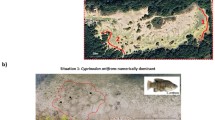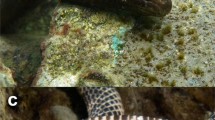Abstract
We conducted a predator bite survey on a population of fathead minnows (Pimephales promelas) considered to be under substantial predation pressure by western plains garter snakes (Thamnophis radix). Scarring, due to failed predation attempts by garter snakes and crayfish (Orconectes virilis), was observed significantly more often in breeding males than in breeding females and nonbreeding minnows. Likely, territorial nest defense under the edges of rocks along the water's edge, a habitat occupied by crayfish and frequented by snakes, caused the breeding males to be differentially vulnerable to predation. Under controlled laboratory conditions, breeding males from this population exhibited an antipredator response to chemical stimuli from live snakes (T. sirtalis andT. radix) significantly more often than breeding female minnows from the same population and breeding minnows of both sexes from a population that was presumed to be under lower predation pressure from snakes.
Similar content being viewed by others
References
Bergerud, A.T. 1971. The population dynamics of Newfoundland caribou.Wild. Monogr. 25:6–55.
Britton, R.H., andMoser, M.E. 1982. Size specific predation by herons and its effect on the sexratio of natural population of the mosquito fish (Gambusia affinis) Baird and Girard.Oecologia 53:146–151.
Burghardt, G.M., Goss, S.E., andSchell, F.M. 1988. Comparison of earthworm and fish derived chemicals eliciting prey attack by garter snakes (Thamnophis).J. Chem. Ecol. 14:855–881.
Carpenter, C.C. 1952. Comparative ecology of the common garter snake (Thamnophis sirtalis), the ribbon snake (Thamnophis sauritis), and Butler's garter snake (Thamnophis butleri).Ecol. Monogr. 22:235–258.
Chivers, D.P., andSmith, R.J.F. 1993. The role of olfaction in chemosensory-based predator recognition in the fathead minnow (Pimephales promelas).J. Chem. Ecol. 19:623–633.
Chivers, D.P., andSmith, R.J.F. 1994a. The role of experience and chemical alarm signalling in predator recognition by fathead minnows,Pimephales promelas.J. Fish. Biol. 44:273–285.
Chivers, D.P., andSmith, R.J.F. 1994b. Fathead minnows (Pimephales promelas) acquire predator recognition when alarm substance is associated with the sight of unfamiliar fish.Anim. Behav. In press.
Chivers, D.P., andSmith, R.J.F. 1994c. Cultural transmission of predator recognition in fishes. I. Intraspecific learning. In preparation.
Drummond, H. 1983. Aquatic foraging in garter snakes: A comparison of specialists and generalists.Behaviour 86:1–30.
Ducey, P.K., andBrodie, E.D., Jr. 1991. Evolution of antipredator behaviour: Individual and population variation in a neotropical salamander.Herpetologica 47:89–95.
Giles, N., andHuntingford, F.A. 1984. Predation risk and interpopulation variation in anti-predator behaviour in the three-spined stickleback (Gasterosteus aculeatus) L.Anim. Behav. 32:26–275.
Göz, H. 1941. Über den Art- und Individualgeruch bei Fischen.Z. Vergl. Physiol. 29:1–45.
Gross, M.R., andSargent, R.C. 1985. The evolution of male and female parental care in fishes.Am. Zool. 25:807–822.
Herzog, H.A., Jr., andSchwartz, J.M. 1990. Geographical variation in the anti-predator behaviour of neonate garter snakes,Thamnophis sirtalis.Anim. Behav. 40:597–598.
Hirsch, S.M., andBolles, R.C. 1980. On the ability of prey to recognize predators.Z. Tierpsychol. 54:71–84.
Holtby, L.B., andHealey, M.C. 1990. Sex specific life history tactics and risk-taking in coho salmon.Ecology 71:678–690.
Huntingford, F.A. 1982. Do inter- and intra-specific aggression vary in relation to predation pressure in sticklebacks?Anim. Behav. 30:909–916.
Johnsson, J.I. 1993. Big and brave: size selection affects foraging under risk of predation in juvenile rainbow trout,Oncorhynchus mykiss.Anim. Behav. 45:1219–1225.
Lawrence, B.J., andSmith, R.J.F. 1989. Behavioral response of solitary fathead minnows (Pimephales promelas) to alarm substance.J. Chem. Ecol. 15:209–219.
Lemly, A.D., andSmith, R.J.F. 1986. A behavioural assay for assessing effects of pollutants on fish chemoreception.Ecotoxicol. Environ. Safety. 11:210–218.
Lemly, A.D., andSmith, R.J.F. 1987. Effects of chronic exposure to acidified water on chemoreception of feeding stimuli in fathead minnows (Pimephales promelas): mechanisms and ecological implications.Environ. Toxicol. Chem. 6:225–258.
Magurran, A.E. 1989. Acquired recognition of predator odour in the European minnow (Phoxinus phoxinus).Ethology 82:216–223.
Magurran, A.E., andPitcher, T.J. 1987. Provenance, shoal size and the sociobiology of predatorevasion behaviour in minnow shoals.Proc. R. Soc. London B. 229:439–465.
Magurran, A.E., andSeghers, B.H. 1990. Population differences in predator recognition and attack cone avoidance in the guppy (Poecilia reticulata).Anim. Behav. 40:443–452.
Mathis, A., andSmith, R.J.F. 1993a. Fathead minnows (Pimephales promelas) learn to recognize pike (Esox lucius) as predators on the basis of chemical stimuli from minnows in the pike's diet.Anim. Behav. 46:645–656.
Mathis, A., andSmith, R.J.F. 1993b. Chemical labelling of northern pike (Esox lucius) by the alarm pheromone of fathead minnows (Pimephales promelas).J. Chem. Ecol. 19:1967–1979.
Mathis, A., Chivers, D.P., andSmith, R.J.F. 1993. Population differences in responses of fathead minnows (Pimephales promelas) to visual and chemical stimuli from predators.Ethology 93:31–40.
McMillan, V.E. 1972. An ethological study of agonistic and reproductive behaviour in the fathead minnow (Pimephales promelas). MSc thesis. University of Saskatchewan
McMillan, V.E., andSmith, R.J.F. 1974. Agonistic and reproductive behaviour of the fathead minnow (Pimephales promelas).Z. Tierpsychol. 34:25–58.
Reimchen, T.E. 1988. Inefficient predators and prey injuries in a population of giant sticklebacks.Can. J. Zool. 66:2036–2044.
Reimchen, T.E. 1992. Injuries on stickleback from attacks by a toothed predator (Oncorhynchus) and implications for the evolution of the lateral plates.Evolution 46:1224–1230.
Reist, J.D., Bodaly, R.A., Fudge, R.J.P., Cash, K.T., andStevens, T.V. 1987. External scarring of whitefish (Coregonus nasus andC. clupeaformis complex) from western Northwest Territories, Canada.Can. J. Zool. 65:1230–1239.
Riechert, S.E., andHedrick, A.V. 1990. Levels of predation and genetically based anti-predator behaviour in the spider,Agelenopsis aperta.Anim. Behav. 40:679–687.
Sargeant, A.B. 1972. Red fox spatial characteristics in relation to waterfowl predation.J. Wildl. Manage. 36:225–236.
Seghers, B.H. 1973. An analysis of geographic variation in the anti-predator adaptations of the guppy,Poecilia reticulata. PhD thesis. University of British Columbia.
Seghers, B.H. 1974. Schooling behavior in the guppy (Poecilia reticulata): An evolutionary response to predation.Evolution 28:486–489.
Siegel, S., andCastellan, N.J. 1988. Nonparametric Statistics for the Behavioral Sciences. McGraw-Hill, New York.
Smith, R.J.F. 1973. Testosterone eliminates alarm substance in male fathead minnows (Pimephales promelas).Can. J. Zool. 51:875–876.
Smith, R.J.F. 1992. Alarm signals in fishes.Rev. Fish Biol. Fish. 23:3–63.
Smith, R.J.F., andLemly, A.D. 1986. Survival of fathead minnows after injury by predators and its possible role in the evolution of alarm signals.Environ. Biol. Fish. 15:147–149.
Smith, R.J.F., andMurphy, B.D. 1974. Functional morphology of the dorsal pad in fathead minnows (Pimephales promelas).Trans. Am. Fish. Soc. 103:65–72.
Author information
Authors and Affiliations
Rights and permissions
About this article
Cite this article
Matity, J.G., Chivers, D.P. & Jan F. Smith, R. Population and sex differences in antipredator responses of breeding fathead minnows (Pimephales promelas) to chemical stimuli from garter snakes (Thamnophis radix andT. sirtalis). J Chem Ecol 20, 2111–2121 (1994). https://doi.org/10.1007/BF02066247
Received:
Accepted:
Issue Date:
DOI: https://doi.org/10.1007/BF02066247




